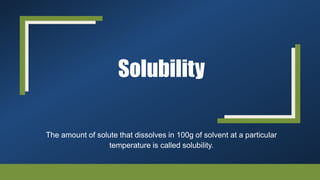Chapter 6 solutions solubility
•Download as PPTX, PDF•
0 likes•16 views
SSCI FBISE
Report
Share
Report
Share

More Related Content
What's hot
What's hot (13)
Solvation and association (Solubility of drug Part -3)

Solvation and association (Solubility of drug Part -3)
Similar to Chapter 6 solutions solubility
Similar to Chapter 6 solutions solubility (20)
Factors Affecting Solubility and Rate of Dissolution.pptx

Factors Affecting Solubility and Rate of Dissolution.pptx
More from Naveed Mallana
More from Naveed Mallana (6)
Chapter 6 comparison of solution, suspension and colloids

Chapter 6 comparison of solution, suspension and colloids
Recently uploaded
“Oh GOSH! Reflecting on Hackteria's Collaborative Practices in a Global Do-It...

“Oh GOSH! Reflecting on Hackteria's Collaborative Practices in a Global Do-It...Marc Dusseiller Dusjagr
Model Call Girl in Bikash Puri Delhi reach out to us at 🔝9953056974🔝

Model Call Girl in Bikash Puri Delhi reach out to us at 🔝9953056974🔝9953056974 Low Rate Call Girls In Saket, Delhi NCR
Recently uploaded (20)
“Oh GOSH! Reflecting on Hackteria's Collaborative Practices in a Global Do-It...

“Oh GOSH! Reflecting on Hackteria's Collaborative Practices in a Global Do-It...
Measures of Central Tendency: Mean, Median and Mode

Measures of Central Tendency: Mean, Median and Mode
Micromeritics - Fundamental and Derived Properties of Powders

Micromeritics - Fundamental and Derived Properties of Powders
Hybridoma Technology ( Production , Purification , and Application ) 

Hybridoma Technology ( Production , Purification , and Application )
TataKelola dan KamSiber Kecerdasan Buatan v022.pdf

TataKelola dan KamSiber Kecerdasan Buatan v022.pdf
Model Call Girl in Bikash Puri Delhi reach out to us at 🔝9953056974🔝

Model Call Girl in Bikash Puri Delhi reach out to us at 🔝9953056974🔝
Chapter 6 solutions solubility
- 1. Solubility The amount of solute that dissolves in 100g of solvent at a particular temperature is called solubility.
- 2. Solubility and Solute-Solvent Interaction • ‘‘Like dissolve like’’ • Intermolecular forces • Strong solute-solvent attractions equate to greater solubility while weak solute-solvent attractions equate to lesser solubility. In turn, polar solutes tend to dissolve best in polar solvents while non-polar solutes tend to dissolve best in non-polar solvents
- 5. Effect of Temperature on Solubility The solubility of solutes is dependent on temperature. When a solid dissolves in a liquid, a change in the physical state of the solid analogous to melting takes place. Heat is required to break the bonds holding the molecules in the solid together. At the same time, heat is given off during the formation of new solute -- solvent bonds. Decrease in solubility with temperature: If the heat given off in the dissolving process is greater than the heat required to break apart the solid, the net dissolving reaction is exothermic (energy given off). The addition of more heat (increases temperature) inhibits the dissolving reaction since excess heat is already being produced by the reaction. This situation is not very common where an increase in temperature produces a decrease in solubility. Increase in solubility with temperature: If the heat given off in the dissolving reaction is less than the heat required to break apart the solid, the net dissolving reaction is endothermic (energy required). The addition of more heat facilitates the dissolving reaction by providing energy to break bonds in the solid. This is the most common situation where an increase in temperature produces an increase in solubility for solids.
